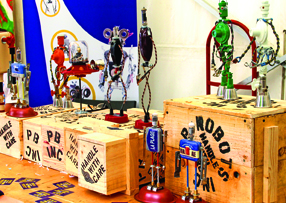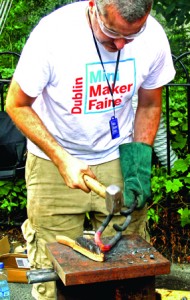
Faire by name and fair by nature, the Dublin Mini-Maker Faire took place during the summer at the Science Gallery on Pearse St, and on the Physics Lawn of Trinity College. This was the second annual faire of its type, intended to showcase homebrew engineering know-how and introduce young and old to the skills and possibilities of what is known as ‘Maker Culture’.
The Maker movement is a type of DIY culture based on using engineering skills to play with – and often re-purpose established technologies. The widespread use of devices such as smartphones and mp3 players has created a need for a layman’s understanding of what is often very technical knowledge. This, and the natural curiosity of engineers, has led to unexpected innovation, with DIY techies creating viable commercial products almost by accident.
The turnout at the Faire was large and the proceedings had a village green feel, with a future-oriented edge that revealed itself on closer inspection of the marquee tents housing the exhibitors. All the exhibitors were running heavily-subscribed free workshops. TOG – the Dublin Hackerspace, a creative workshop based in Chancery Lane hosted basic How to Solder lessons where visitors constructed the circuitry for their own flashing LED badges and the Physics in the Field tent hosted Paper Glider and Cardboard tube Rocket seminars. An array of foot-pumps lined the cricket pitch of the Physics lawn for the periodic test launches.

The practical skills on display ranged from the high-tech to the very ancient. In the latter category, Galway-based sculptor Donnacha Cahill demonstrated metalworking with forge, hammer and anvil. He fielded questions about creating his sculptures in metal, some of which were on display. One example was a snarling metal Doberman (a version of which can be seen on exiting the Arrivals lounge of Dublin Airport). Another was an impressively-horned ram.
More contemporary was the Fabrication Zone tent. Arguably the star attractions there were the 3D Printers, which constructed whole-piece models (such as a hard plastic Statue of Liberty) layer by layer. The Fabrication Zone also hosted a CNC (Computer Numerical Control) machine: very finely controlled sculpting tools operated by a design-assisting computer. The result was a ‘desktop fabrication mill’ that could produce a whole machine, piece by piece, on spec, based on designs fed into the computer.
Pictured from top: PBRobots, a selection of robots made from found parts; Donnacha Cahill, sculptor.
By Ruairi Conneely

